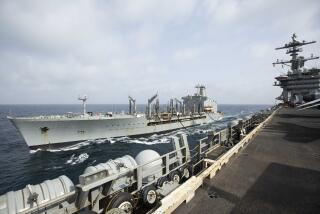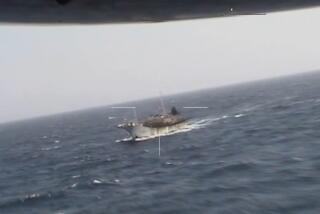Fighting piracy becoming a larger role for the Navy
- Share via
ABOARD THE USS TARAWA, PERSIAN GULF — From a computer screen on this amphibious assault ship, U.S. sailors kept close watch on a 6-week-old drama more than 2,500 miles away involving pirates from Somalia and a Danish merchant vessel.
A second American warship was off the coast of Somalia near the captive vessel, a 115-foot tugboat called the Svitzer Korsakov with an international crew.
As long as the pirates didn’t mistreat the crew and continued to negotiate a ransom with the ship’s owner, the U.S. would not intervene. But if the pirates became violent or deprived crew members of food and water, heavily armed U.S. sailors were prepared to storm the Svitzer Korsakov and free the crew.
“We want the pirates to know there will be consequences if they escalate,” said Rear Adm. Mark Balmert, commander of Expeditionary Strike Group Three and point man for the Navy’s 5th Fleet on piracy in the region.
The consequences are real: In October, the U.S. guided-missile destroyer Porter sank two pirate skiffs after receiving a distress call from a Panamanian-flagged, Japanese-owned cargo ship in international waters in the Indian Ocean.
Fighting piracy on the high seas is an increasingly significant part of Balmert’s overall mission to maintain maritime security in an ever-volatile region.
Although the United States, along with various partners, has long taken on the job of maintaining stability in the Persian Gulf and Gulf of Aden, the mission has expanded in the last year to include piracy off Somalia. Since October, the United States, leading a coalition of 20 nations, has kept at least one warship in international waters off Somalia.
U.S. sailors also are on the lookout in the Persian Gulf for pirates who might attack the smaller merchant ships and dhows.
“We’re like a cop walking a beat,” said Capt. David Adler, commander of the guided-missile cruiser Port Royal in the Persian Gulf. “We haven’t had any piracy incidents, but that’s because we’re here.”
Pottengal Mukundan, director of the London-based International Maritime Bureau, said involvement of the U.S. Navy and its coalition partners “may prove to be the only way to stop the pirates, which have until now shown complete disregard for the law.”
The waters off Somalia, connecting the Red Sea and the Indian Ocean, has become a favorite hunting spot for pirates.
Although attacks have declined in more traditional pirate areas such as the waters around Indonesia and Bangladesh, incidents off Somalia have increased, with pirates showing a greater tendency toward violence, according to the International Maritime Bureau, a division of the International Chamber of Commerce.
Thirty-one acts of piracy were reported off Somalia in 2007, more than anywhere else in the world and a 10% increase from the previous year, according to the bureau. Pirates held 154 crew members hostage. A Chinese sailor aboard the fishing trawler Ching Fong Hwa was killed in pirate incident.
The shipping industry and insurance companies prefer to negotiate for the release of the ships and crews and have asked the U.S. to stand off unless loss of life appears imminent. Negotiations can drag on for months, while the U.S. ships keep in contact with both the pirates and the captains of the seized vessels.
“It’s sort of a standoff now,” said Vice Adm. Kevin Cosgriff, commander of the 5th Fleet, based in Bahrain. “If the pirates just hold the ships and crews for ransom, that’s one thing. But if the pirates change the rules and get violent, that’s when the shipowners get excited. That’s why we’ve told the pirates: ‘If you change the rules, we’ll change the rules and you won’t like it.’ ”
This month, the International Maritime Bureau warned merchant vessels to be wary of fishing boats or dhows asking for assistance. Pirates use such tactics to trick merchants into stopping to render aid, under the immutable law of the sea.
The U.S. is bracing for a possible increase in piracy incidents off Somalia as summer approaches, bringing smoother seas. In late January, a swarm of pirate boats took over the Svitzer Korsakov, which was bound for Russia’s Sakhalin island near Japan. On board were a British captain, an Irish mate and four Russian sailors. A U.S. ship reportedly fired warning shots at a boat resupplying the pirates.
The U.S. was in daily communication with the Svitzer Korasakov to determine the condition of its crew.
“The captain will say, ‘We’re fine,’ and then one of the pirates will grab the microphone and say, ‘That’s enough,’ ” Balmert said.
Through interpreters, the U.S. told the pirates that it wouldn’t stand by if the merchant sailors were harmed.
On March 19, the standoff finally ended: The pirates released the ship after a reported $700,000 ransom was paid.
--
More to Read
Sign up for Essential California
The most important California stories and recommendations in your inbox every morning.
You may occasionally receive promotional content from the Los Angeles Times.













